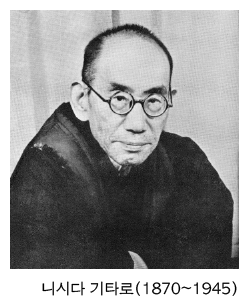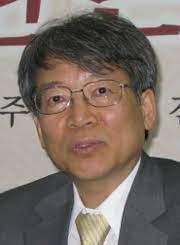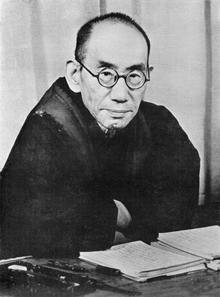생명철학과 역사철학을 전개하다*
머리말
하나의 역사적 사건에 대해 한국인과 일본인은 종종 상반된 역사적 기억을 지니고 있다. 이토 히로부미(伊藤博文, 1841~1909)의 죽음이 그런 사례다. 이토는 일본에서는 최초의 내각총리대신, 조선 통감을 역임한 자, 일본 입헌정치를 확립한 정치가 등으로 불리고 있다. 하지만 한국인의 뇌리에는 주로 일본 제국주의의 수괴, 침략의 원흉, 동양 평화를 파괴한 주범으로 각인되어 있다. 우리는 의사 안중근(1879~1910)의 가해 행위를 통하여 이토를 민족의 원수로 기억하지만, 당시 일본인 대부분에게 안중근은 흉악범이고 사형받아 마땅한 인물이었다. 이와 같이 상반된 역사적 기억의 배후에는 한국인과 일본인은 별개의 생존과 생육 단위로서 살아왔다는 역사적인 사실이 놓여 있다.
진리 주장이 ‘나’와 ‘우리’ 그리고 민족과 국가라는 생존 단위를 초월할 수 있을까? 이와 같은 질문을 니시다 기타로(西田幾多郞, 1870~1945)와 그의 철학을 향해 던져 보자. 그는 20세기 일본이 배출한 가장 탁월한 철학자의 하나로 일본 내외에서 널리 인정받아 왔다. 그의 철학은 근대일본의 복잡다단한 모습을 보여주고 있다. 니시다 철학은 상당히 ‘보편적’ 메시지를 담고 있음에도 불구하고, 한 나라에서 통하는 진리가 현해탄을 건널 수 있을까 하는 질문을 한 · 일 양국인에게 던지고 있다.
생명과 논리, 이 둘은 니시다의 평생 화두였다. 그가 40여 년 동안 추구했던 생명에는 내적 생명과 역사적 생명, 둘이 있지만 논리는 거의 하나다. 결론부터 말하자면, 개인 구원과 관련된 생명철학은 현해탄을 건너기 쉽고, 역사철학은 몹시 어려워 보인다.
1. 생명철학

27세(1897) 무렵 야마구치 요시키츠(山本良吉)에게 보낸 편지에서, 니시다는 선(善)과 ‘진정한 자기[眞正の己]’를 탐색해야 할 장소로 깊고 깊은 ‘마음속(奧)’을 말하고 있다. 20대에 쓴 것이지만 니시다 철학 전체의 방향을 잘 보여준다. 자기의 내심으로 깊이 들어가 욕, 망념, 불쾌, 불만, 비천함의 근본을 자르고, 마음속 깊은 곳에 있는 진정한 자기를 얻는 데서 선(善)은 구현되고 생명도 얻는다; 선 이외에 다른 것에 억눌리면[他に壓せられ已たる] 죽음이다; 진정한 자기와 하나 되는 시간이 1분이어도 생명은 영원하다고 했다(18: 44). 1분의 영원은 ‘영원의 지금’이나 ‘절대현재의 자기한정’이란 말의 선구다.
이 편지에서처럼 생명이 육신이 아니라 이상(理想)에 있다고 하면, 육욕의 극복이 진정한 자기를 찾기 위한 전제조건이 된다. 결혼 이듬해에 보낸 편지에 26세의 니시다는 가족이 육욕을 허용하는 귀굴(鬼窟)이라고 했다. 신체에 대한 이런 부정적인 견해는 나중에 예술론, 표현론, 신체론에 나오는 ‘영화(靈化)된 신체’ 등의 개념을 통해 일부 극복된다. 진실재는 육신을 떠날 수 없고 오히려 신체를 통해서만 표출된다고 말하게 된다.
1899년(29세) 제4고등중학교(4고) 전임교수가 되던 해에 쓴 일기에 선(禪) 수행과 관련된 사항이 계속 나온다. “2월 1일 방하제연(放下諸緣), 순일무잡(純一無雜)” “2월 21일 효기타좌(曉起打坐) 정신 굉대(宏大)되는 것 같다.”(17: 35) 순일무잡의 경지에 도달하기 위해 연을 놓아야 하고 그러기 위해서는 좌선이 최고다. 그런데 2월 23일 일기에는, 학문을 해야 한다는 생각을 방해하는 일이 많다고 하며, 중국 당대의 선사 덕산선감(德山宣鑒, 780~865)의 일을 말하며 경계하자고 했다.
니시다는 1902년(32세) 무렵 스즈키 다이세츠((鈴木大拙, 1870∼1966)에게 편지를 보냈다. 거기에 서양 윤리학이 완전히 지식적 연구를 함으로써, ‘자기의 각근하(脚根下)를 잊어버린다’는 구절이 나온다. 《벽암록》의 ‘발밑을 살펴라[照顧脚下]’를 상기시킨다. 제대로 된 윤리학이라면 ‘발밑’을, 즉 인심의 깊은 영적 경험(soul-experience)을 살펴야 한다; 윤리학은 이런 영적 경험에 효능이 없는 허위의 조물이다; 하지만 직무상 부득이한 자신의 강의를 양해해 달라는 내용이었다(18: 59~60 〈서간〉 42). 1902년의 한 일기에서는 학(學)의 긍정적인 용도를 말한다. “참선으로 대도를 밝히고 학문으로 참된 지를 열고, 도를 체를 삼고, 학문을 사지로 삼는다(參禪以明大道 學問以開眞智 以道爲體 以學問爲四肢 17: 99).”고 했다. 참선이 밝힌 대도가 몸통이라면 학문은 팔다리라는 것이다.
4고(四高) 교수였던 니시다는 4고의 교우지 《북진회잡지》에 〈인심의 의혹〉(1903)이란 글을 게재했다. 이 글에서 그는 학생에게 ‘진지한 인생 문제’에 맞서라고 권한다. “생은 어디서 와서, 사(死)는 어디로 가는가, 사람은 무엇을 위하여 살아가고 무엇을 위하여 일을 하는가, 무엇을 위하여 죽는가, 이것이 최대 최심(最深)의 인심의 의혹이다.”(13: 86∼87) 인생 문제란 우리가 먹고, 자고, 깨고, 사랑하고, 분노하는 일(怒る)에서 “곧바로 이 마음에 있어서 천지(天地)의 관계를 구하고 신의 마음을 구하고 해탈의 경계를 구하려고 하는, 지극히 실지에 적절한 연구”라고 했다(13: 88∼89). 일상을 살아가는 내 마음에서 신의 마음과 해탈의 경계를 구하자고 했다. 인심의 의혹을 느낄 때, 니시다는 석가나 기독과 같은 심령적 위인을 찾아야 한다고도 했다(13: 89).
순수경험이란 무엇인가?
니시다는 《선(善)의 연구》에서 직접경험, 순수경험, 지적 직관에 대해 거듭 언급하고 있다. 이것들은 모두 주객미분의 상태로 자기의 세공(細工)이 조금도 섞이지 않은 경험이고, 생명 포착의 순간이고, 가정(假定) 없는 진실재의 순간이다. 순수경험의 사례들은 다양하다. 색(色)을 보고 음(音)을 듣는 순간, 열심히 벼랑길[斷岸]을 기어 올라가는 경우, 음악가의 숙련된 연주, 동물의 본능적 동작, 이것들이 순수경험이다. 그리고 괴테가 꿈속에서 직각적으로 시를 지은 일, 종교인의 피아합일(彼我合一)에 대한 직각, 모차르트가 작곡할 때 그림이나 입상(立像)처럼 악보 전체를 직시(直視)한 것, 이것들은 직각의 순간 속에 이미 전체나 일반이 깃들어 있음을 보여주는 순수경험의 사례다. 이것들 이외에 학자가 새로운 사상을 얻고 종교가가 새로운 각성을 얻게 되는 것, 화가에게 흥(興)이 일어나 화필이 저절로 움직이는 것, 이런 것들도 모두 어떤 통일의 발현에 근거를 두고 있는 사례, 또는 그 속에 통일적인 그 무엇이 작용하고 있는 순수경험의 사례다. 공통점은 ‘하나’가 전체로서 먼저 온다는 것이다.
우리가 아름다운 음악에 넋을 잃고 물아상망(物我相忘)하고 천지가 하나의 맑은 음악 소리[樂聲]로 되는 찰나, 화가가 의식적인 다년간의 다양한 기도(企圖)와 고심의 결과 “기예가 내면에서 성숙하여 뜻(意)에 이르고 붓이 스스로 따르는” 경지(1: 154), 한 폭의 그림과 한 곡의 악보에 있어서 그 일필(一筆)과 일성(一聲)이 전체의 정신을 나타내는 경우, 도덕적 인격의 발현, 그리고 플라톤이나 스피노자의 철학과 같은 위대한 사상의 배후에 커다란 직각이 작용한 경우, 이 모든 것들이 순수경험의 실례이다. 하나 속에 전체가 나타나는 것을 니시다는 경(景)이나 광경(光景)이라 부르기도 했다.
일거수일투족 그리고 의식 하나하나도 모두 순수경험이 될 수 있다.
우리의 손이 움직이는 곳, 다리가 밟는 곳, 거기에 우리의 전 인격이 있다고 말할 수 있다. …… 명장(名匠)의 일필일도(一筆一刀)의 중에도 전 창조력이 담기어 있듯이, 개개의 의식은 모두 우리의 의지, 우리의 인격의 창조이다. 이 때문에 나는 모든 작용을 통일하여, 나는 자유라고 말할 수 있다. 우리는 신상(神像)과 같이 된 것이다.
— 〈절대자유의 의지〉 2: 290∼291
명장의 붓놀림에서처럼, 우리의 동작 하나와 의식 하나에도 인격 전체가 드러날 수 있다. 그 순간 몸은 자유의 신상이 된다. 물론 성숙을 위한 사전 준비도 있어야 한다. 니시다 철학은 일거수일투족에 대한 행위/동작의 철학이다.
순수경험의 특성

순수경험은 의식의 통일, 주객의 합일 상태이다. 자기의 의식상태를 경험하는 것이 사실을 그대로 아는 것이며, 경험 중 가장 순수한 실재이다. 순수경험은 다음과 같은 특성을 갖는다. 첫째, 순수경험은 수동이 아니라 능동이고 생명의 활동이다. 생명의 활동 그 자체가 실재이다. 순수경험이 독립자전(獨立自全)의 순활동이고 유일의 활동이다. 니시다는 《선의 연구》와 거의 같은 시기에 집필한 《순수경험에 관한 단장(斷章)》에서 “열반도 소승불교처럼 무가 아니라 활동이다. 천지합일의 대(大)활동이 된다”고 했다(16: 520). 그는 또 소승불교의 무(無)를 비판하면서, 열반을 대활동으로 이해한다. 역사철학의 니시다는 역사적 행위를 내세워 대승불교를 찬양하게 된다.
둘째, 순수경험의 경우 “개인이 있고 경험이 있는 것이 아니라, 경험이 있고 개인이 있다.”(1: 28) 경험의 소유주와 활동자는 활동에서 추출해 낸 추상적 개념에 불과하다(1: 71). 셋째, 순수경험은 “색을 보고, 음을 듣는 찰나”에 성립하는 찰나의 경험이다(1: 9). 순수경험은 현재의 순간 경험이고 과거의 기억이나 미래에 대한 기대와 우려로 훼손당하지 않는다는 의미에서 찰나적 충만의 경험이다. 넷째, 순수경험은 하나의 ‘개체’로서 유일의 특색을 가지므로(1: 27) 어느 일반자에 귀속되지 않는다. 즉 그것은 개체적(또는 개물적)이며 개성적인 사건이다.
다섯째, 순수경험이나 직접경험이 진실재가 되기 위해 논리가 필요하다. 니시다는 《선의 연구》(1911)의 〈실재〉 편 제4장과 5장을 각각 〈진실재는 언제나 동일한 형식을 가지고 있다〉와 〈진실재의 근본적 방식〉으로 부르고 있어서, 일찍부터 논리나 형식 추구에 관심이 컸다. 생명과 같은 독립자전(獨立自全)의 진실재가 성립하는 방식은 무엇인가? “먼저 전체가 함축적(implicit)으로 나타난다. 거기에서 그 내용이 분화 발전한다”(1: 63)고 했다. “하나의 것(一つの者)이 자기 자신에 있어서 발전 완성하는 것이다. 이 방식은 우리의 활동적 의식작용에서 가장 분명하게 볼 수 있다.”(1: 63∼4) 전체로서 하나가 먼저 온 다음에 분화 발전한다.
그런데 《선의 연구》가 말하는 선(善)은 무엇인가? 선은 인격의 실현, 의식통일, 자타상망, 주객상물의 경지에 도달함이다; 자기와 우주는 동일하다; 실재를 아는 것은 자기 자신을 아는 것; 결국 실재의 진선미는 자기의 진선미다. 그런데 주객상몰이 확대되면 인류 일반의 통일적 발달로까지 진행한다고 했다(1: 163∼164 참조). ‘인류 일반의 통일적 발달’이 무엇인지는 분명하지 않다. 후기의 역사철학에서 중시되는 국가나 국체는 여기에는 아직 나타나지 않았다. 역사철학의 입장에서 보면, 순수경험 시기의 선(善)은 비역사적이고 비국가적이며 추상적이었다고 해야 할 것이다.
2. 생명의 논리
니시다에게 사람의 행위에는 두 종류가 있다. 하나는 자유, 독립, 창조, 생명의 행위이고, 다른 하나는 부자유, 의존, 반복, 죽음의 행위이다. 전자가 능동성과 개성의 ‘함’이라면, 후자는 수동과 몰개성의 ‘당함’이다. 주로 욕망과 과거의 업이 일으킨 행위다. 그 특성은 위축과 쇠약 그리고 의기소침이다. 쇠잔하고, 느른해지고, 사그라지고, 까라진 동작[위미소침(萎靡消沈)]이다.
한 사람이 ‘당함’의 위축과 쇠약, 부자유를 간파하고, 자유와 능동의 ‘해탈’의 꿈을 품게 되었다고 해보자. 그/그녀는 깊디깊은 자신의 속내로 들어가, 참자기가 주는 생기를 경험했다. 그 사람의 동작 하나하나가 수면 위로 솟구쳐 오르는 물고기처럼 생기에 차 활발하게 움직이게 되고, 행주좌와의 매 순간 심신이 통일되니 위축과 쇠약이 있을 리 없다. 일거수일투족에서 자유와 독립은 물론이고, 완전무결의 당위와 절대의 감마저 느끼며 구원이나 해탈을 성취하게 된다. 여기에 비로소 몸과 마음이 하나가 되고, 몸은 신상(神像)이, 마음은 신격(神格)이 되며, 진선미가 일거에 실현된다. 단박 실현되는 이런 순간 동작이 구원과 해탈의 동작이며, 바로 ‘한 순간’이다.
니시다 철학은 ‘한 순간’에 대한 철학이다. 그는 생기나 활력으로 가득한 손놀림과 발걸음의 한 순간을 ‘이것(Dies)’이라고 부른 적이 있다. 생명의 한 순간은 참 자기와 진실재의 순간이다. 이는 순간적 동작/사건이다. 이를 니시다는 개물(個物)이나 개(個)로, 또는 사(事), 사실, 물사(物事)로도 불렀다. 한 순간이라는 시간은 물(物)을 담아내는 형식적인 시간이 아니라, 자기동일의 내용과 힘으로 충만한 시간이다. 이상으로 본다면 매 순간 그런 순간이어야 하고, 그런 순간이 없다면 죽음이다.
니시다는 1901년 수년 전부터 알아오던 임제종 세츠몽(雪門, 1850∼1915) 선사로부터 계도 받고 슨신(寸心) 거사라는 이름도 얻었다. 《임제록》에 “이르는 곳마다 주인이 되면 서 있는 곳마다 진여 바로 그 자리(隨處作主 立處皆眞)”라는 구절이 나온다. 아래 인용에 나오는 절대무의 자각과 자유라는 말은 이런 구절의 철학화라고 할 수 있다.
절대무의 자각이 깊어지면 질수록, 각인의 자기는 각인의 자기로서 자유로이 행위하는 것이다. 하지만 이렇게 각인의 자기가 각인의 자기로서 자유이고, 자기가 자기이며 동시에 자기에게 외적인 것이 자기 자신의 운명으로서 자기 자신의 깊은 내용이라고 생각되지 않으면 안 된다. 외적인 것이 내적인 것으로 된다. 이런 입장에서는, 감각적인 것도 내적 생명의 질료로서 종교적인 것이 되지 않을 수 없다.
— 〈일반자의 자기한정〉 1929, 5: 411.
‘외적인 것이 운명으로서 자기 자신의 깊은 내용’이란 구절은, 외적인 것도 거부할 수 없는 현실이란 뜻이다. 자각에서는 내 · 외가 하나가 되고 감각적인 것도 종교적인 것이 된다.
니시다가 생명의 한 순간에 논리를 부여한 점에서, 여느 전문 선(禪) 수행자와, 선불교의 신비주의적 측면을 강조한 스즈키 다이세츠(《불교평론》 2020년 여름호, 박인석)와도 달라 보인다. 논리 없이는 ‘니시다 철학’이란 말도 생기지 않았을 것이다. 니시다 철학은 생명의 창조적 약동 하나하나, ‘한 순간’의 생명 사건이라고 할 만한 것을 존재론의 중심에 두고 있다는 의미에서, 동작/사건 존재론이라 할 수 있다. 그가 동작/사건에 대한 정치한 논리를 치열하게 추구했던 점에서, 일본의 대표 정도가 아니라 세계의 일류 철학자로 볼 수 있다. 생명이라는 단어가 선 수행이나 베르그송과 같은 서양 철학자에서 온 것이라면, 논리 부여는 생명철학을 보편화하겠다는 철학자로서의 소명의식에서 온 것이었다.
서양철학서를 읽으면서, 그가 서양철학의 대표 논리로 파악했던 ‘일의 다(一の多)’ 논리를 비판하고, ‘일즉다(一卽多)’, 개물즉일반(個物卽一般), 일반즉개물 또는 특수즉일반(特殊卽一般), 일반즉특수라는 생명 논리를 창안하여 그걸 부단히 벼려 나갔다. 바로 이 점에서 니시다 철학은 양이론(攘夷論)이다.7) 하지만 역사 참여의 행위에서조차 절대의 ‘한 순간’이 성취된다는 역사철학의 행위론은 개인의 자유와 능동성, 그리고 양이론도 변질시키고 만다.
3. 역사철학
수많은 일본인에게 1931년부터 시작된 15년 전쟁기는 절체절명의 위기였을 것이다. 니시다는 1930년대 역사적 · 정치적 맥락에서 민족이라는 종(種)과 국가, 그리고 역사적 사건과 행위를 사유의 주 대상으로 삼지 않을 수 없게 되었다. 특정 시대와 그 시대에 발생하는 모든 것―가령, 천황, 국체(國體, national polity)를 비롯하여 법률제정 행위, 동아공영권 등―이 엄숙한 현실로서 그리고 절대적인 실재로서, 일본인에게 임(臨)해와 응전하도록 명령해 오니, 마음속으로 도망갈 수도 없고, 몸을 숨길 데도 없다. 천황이나 국체는 부정과 돌파의 대상이 아니라 직면과 순종의 대상인 것이다. 한 사람 한 사람이, 역사의 부름을 받아 나선 이 몸이 되는 것이다. 이제 내적 생명의 발현에서가 아니라, 역사적 세계 즉 민족 공동체의 내부에 창조적 역군이 되는 일에서 주체성과 자유가 추구되어야 한다.
전집 11권의 논문 〈예정조화를 실마리로 해서 종교철학에로〉(1944)에, 일본의 국체가 바로 대승불교의 참정신의 재현이라고 주장하는 대목이 나온다.
우리의 자기는 절대현재의 순간적 자기한정으로서, 하나하나의 순간에 있어서 종말론적 입장에 서 있다. 현재가 현재자신을 한정하는 입장에서는, 하나하나의 순간이 세계의 시작이고 끝이다. 역사가에 의해서도, 역사적 세계에서는 모든 점이 시작이고 끝이 된다고 생각된다(랑케). 금일의 불교도는 이런 대승의 참된 의의를 망각하고 있다. ……절대현재의 자기한정으로서 아국의 국체란 것은, 이런 입장에서의 역사적 행위의 규범이다. 앞서 말한 대승의 참된 정신은, 동양에서 금일, 우리 일본에서만 유지되고 있다.(11: 132∼33)
‘아국의 국체’를 절대현재의 자기한정으로 이해하는 데에 대승의 참된 의의가 있다고 한다. 랑케의 사유와 대승불교를 직접 연결하면서, 대승의 참된 정신이 동양의 일본에서만 유지되고 있다는 니시다의 말은 우리에게 아주 거북하다. 결국 일본의 생존과 생육을 위한 것이다.

4. 전회와 그 문제
니시다가 내적 생명의 추구에서 얻어낸 자각의 형식을, 역사적 생명의 활동에까지, 즉 시대나 국가 등의 비의식적인 현상에까지 확대 적용하게 된 것을, 필자는 니시다 철학 내의 전회(turn)라고 불러 보았다. 그 전환은 1931년경 일어났으며, 최초기에 무관심과 방기의 대상이었던 부질없는 세상(浮世, うきよ)을, 그리고 순수경험기나 절대무의 자각의 철학기에 2위 또는 3위에 머물러 있었던 역사계를 최상위로 끌어올리게 된다. 그 전회는 초기의 종교적 · 구원론적인 자각의 철학에 대하여, 완전 부정은 아니더라도, 상당한 수정과 비판을 초래하게 된다.
여기에 문제가 있다. 역사적 · 정치적 행위에서도 절대의 ‘한 순간’을, 그 안에서도 자유, 독립, 창조, 역동의 힘을 경험할 수 있을까? 천왕과 국가가 거부할 수 없는 절대 영원의 역사적 현실/실재로서 개인에게 다가오고, 이와 같은 현실재에 직면한 개인이 완전무결한 창조행위를 할 수 있을까? 1930년대의 니시다는 그 가능성과 당위성을 철학적으로 주장했던 것으로 보인다. 일본/일본인의 능동적 행위가 중국인과 조선인에게 강요와 억압이 될 수 있음을 그가 상상인들 했을까?
니시다가 영국과 미국으로 대표되는 서양 제국주의에 대항하기 위하여 윌슨의 민족자결주의를 반대하고, 동아공영권의 기치를 높이 들고 천황을 중심으로 동아시아 각국이 단결해야 한다고 썼을 때, 그는 유사 제국주의자가 되었다. 그가 저항논리로 개발했던 ‘일즉다’의 논리를 스스로 ‘일의 다’의 논리로 전락시키고, 그 일(一)이 낳은 폭력을 정당화하고 말았다.
5. 니시다 철학: 근대일본의 두 얼굴
니시다 철학은 우리에게 적어도 두 개의 얼굴로 다가온다. 한 얼굴에서는 생명의 약동을 보고, 또 다른 얼굴에서는 제국주의 일본을 본다. 진정한 자기라는 생명의 샘에서 솟아나는 절대영원의 행위는 구원의 몸짓이다. 이는 특정한 시공을 초월하여 순수무(無)의 절대 공간에서의 구원이므로, 인류 모두의 것이 될 수 있다. 순수무의 경험에서 실현되는 영웅과 대인은, 자신의 땅이 주는 몸의 기억과 전통에 붙잡히지 않고 국가주의나 민족주의를 초월할 수 있는 보편적 인간이 될 수 있다.
니시다 철학의 두 얼굴은 근대일본의 두 얼굴이기도 하다. 하나는 일본문화의 내부에서 고유의 것을 찾아 이를 정밀하게 다듬어 세계적 ‘보편’으로 현양하려는 당당한 모습이고, 또 하나는 영미 제국(帝國)과 동아시아 제국(諸國) 사이에서 생존하고 확장하기 위해서, 천황제를 열렬하게 주창하는 중간자의 모습이다.
두 얼굴을 가진 것은 일본만이 아니다. 검은 배를 우라가(浦賀) 만에 띄워 일본의 조정을 소스라치게 놀라게 했던 당시의 미국 역시 두 얼굴의 소유자였다. 미국도 실리 추구와 함께 보편진리를 주장했다. 이토를 비롯한 메이지와 쇼와의 수많은 일본인 지도자들은 서양 세력이 규정했던 보편적인 것들을 수용해서 자기의 것으로 바꾸어 나갔다. 1930년대에 이르러 동아공영권의 기치 아래 일본이 중심이 되어 영미 제국주의에 대항하는 것을 일본의 세계사적 사명으로 삼았다. 니시다는 이를 수용했다.
니시다의 역사적 행위론은 위기에 처해 있던 일본인 집단의 생존과 생육과 관련되어 있는 것 같다. 일본에 대한 한국인의 진리 주장은 집단의 생존 · 생육의 본능에서 독립할 수 있을까? 니시다의 역사철학이 던지는 질문이다.

6. 생존과 생육의 본능은 살인한다
진리와 비폭력을 실천해온 마하트마 간디는 나이 40에 〈용감한 일본 병사〉(1909)라는 짧은 논평을 남겼다. 간디가 1909년 영국 런던을 방문하던 중, 이토 히로부미가 ‘어떤 한국인’에게 암살당했다는 소식을 접했다. 일본 병사는 이토이고 어떤 한국인은 안중근 의사다. 그런데 간디는 이 논평에서 두 사람 모두를 비판했다. 이토는 이웃 약소국을 침략했고, 안중근은 민족이라는 이름으로 이토를 저격해서 죽였으므로 두 사람 모두 비폭력 원리를 어겼다는 것이다.
간디는 이 논평에서 일본을 러시아의 피를 맛본 나라로, 세력에 도취한 나라로, 그리고 칼을 휘둘렀으니 칼로 망할 나라로 보고 크게 책망하며 패망을 일찌감치 예견했다. 간디의 눈에 비친 이토는 용감한 자였지만, “한국을 예속시킨 것은 그가 용기를 나쁜 목적에 사용한 것”이라고 했다. 간디는 일본과 같은 나라가 서양문명의 마법에 홀려 그것을 수용해서 세력을 키우면 그 세력으로써 자신을 다스리고, 자기를 확장하여 약한 한국을 정복할 수밖에 없다고 말했다. 서양문명이 주는 세력이 제국주의 형성의 기초임을 간파했던 것이다.
간디는 이 글을 “인민의 참된 복지를 심정에서 생각하는 자라면 오직 사탸그라하의 길을 따라 인민을 인도해야 할 것”이라는 구절로 끝냈다. 이 길은 물론 비폭력의 길이다. 안중근의 행위에 대한 간디의 비판에도 불구하고, 한국인이 한민족의 정체성을 일본과의 관계에서 찾는 한 안중근은 의사(義士)로 기억될 것이다. 여기에 비폭력 원리와 애국애족 원리가 충돌하고 있다.
이토는 물론 비폭력과 같은 보편윤리를 믿지 않았다. 1871년 미국에서 일본 정부에 보낸 의견서에서 문명의 지체를 막기 위해서, 보편윤리[普通의 正理] 대신에 국익을 선택해야 한다고 했다.
이토는 민족주의자 안중근의 가해로 죽고, 안중근 역시 가해한 지 정확히 6개월 뒤 처형당했다. 보편윤리를 주장한 간디도 힌두 민족주의자 나투람 고제(Nathuram Godse, 1910∼1949)에 의해 살해당했다. 그는 간디가 이슬람교도에게 지나친 유화정책을 쓰는 일에 격분해서 간디를 죽였다. 그는 《힌두정기(Hindutva)》의 저자인 사바르까르의 영향을 받았고 확신범이었다.
니시다가 타고난 강성 제국주의자는 아니었던 것으로 보인다. 러일전쟁(1904∼1905) 승리에 대해 유쾌하다고 했다가 여순 함락의 축하회에 대해서는 인심의 부박(浮薄)을 지적했다. 1909년 10월 26일 일기에 “밤 이토 공 할빈에서 암살당했다는 호외 나오다. 오늘 저녁 사상의 단서를 좀 얻었다.”고 간단히 적었다(17: 229). 대다수 일본인에게 충격적인 이토의 죽음에 대한 애도나 분노가 없었다. 오히려 자신의 ‘사상의 단서’를 얻었다고 했다. 역사철학의 니시다였다면 분노했을지도 모른다.
젊은 니시다는 붓다와 예수를 심령적 위인으로 불렀다. 붓다와 예수는 엄격한 도덕적 서약, 사랑과 비폭력을 지키면서 심령의 가장 깊은 곳까지 도달했던 인물로 이해해보자. 니시다가 수계(受戒)는 했지만 끝까지 가지는 못했다. 한국인이나 일본인 대중 가운데 니시다보다 나은 사람이 얼마나 있을까? 민족이나 국가, 정치 진영과 같은 현실적 유혹을 만나면 대다수 인간은 그 유혹에 지고 만다.
결론: ‘우리 함께’ 할 일을 찾자
달라이 라마는 1989년 12월 10일 노르웨이 오슬로에서 노벨평화상 수락 연설을 했다. 제목은 〈간디에 대한 찬사〉이다. 그가 노벨평화상을 수상하는 이유는, 이 평화상이 붓다를 비롯한 인도와 티베트의 위대한 성인을 따라서 그가 실천하려고 하는, 애타주의, 사랑, 자비와 비폭력의 참된 가치를 인정했기 때문이라고 했다. 그리곤 “나는 이 상을 마하트마 간디에 대한 찬사의 표시로 수상합니다. 그의 삶이 나에게 가르침과 영감을 주었습니다.”라고 연설했다. 달라이 라마는 중국 통치하에서 고통을 겪고 있는 6백만 동포 티베트인들에게 이 상을 바친다고 했다. 그런데 놀라운 점은 중국인에 대한 분노나 증오, 원한을 부추기지도 않았고 무장봉기, 테러리즘을 선동하지도 않았다.
그는 다음 기도로 이 연설을 마쳤다.
나는 억압자와 친구 모두를 위해, 우리 함께 인간적인 이해와 사랑을 통해, 보다 나은 세계를 건설하는 데 그리고 모든 중생의 고통을 줄이는 데 성공할 수 있도록 기도합니다.
중국은 티베트를 점령 중이다. 그런데도 달라이 라마는 중생의 고통을 줄이는 데 ‘우리 함께’ 일을 하자고 권하고 있다. 우리 속에는 당연히 중국인도 포함된다.
우리가 일본 역사나 정치, 그리고 일본불교를 다룰 때, 뭔가를 비판하면서도 ‘우리 함께’ 해야 할 일을 찾는 것이 모두의 미래를 위해 유익하다. 이것이 싫으면 남은 길은 단 하나다. 조선이 일본의 침략에 앞서 스스로 자멸했다는 한용운의 자기책임론을 앞세워 부국강병으로 나가는 길, 그리고 그가 시에서 노래했듯이 이순신과 을지문덕 같은 장군을 찾는 길밖에 없다. 이때 군사력의 크기는 우리를 방어할 정도면 족하다.
누가 니시다에게 돌을 던질 수 있으랴? 자신과 자신이 몸담은 집단, 이 양자의 생존과 생육을 초월하여 진리 주장을 할 수 있는 자만이 돌을 던질 수 있다. 순수와 절대의 한 순간을 참으로 경험하여 민족이나 국가를 초월할 수 있는 자만이 니시다에게 돌을 던질 수 있다.
《불교평론》의 필자나 독자들은 얼굴이 하나인가, 둘인가? 둘이라면 우리와 니시다는 서로 닮았다. ■

허우성 woohuh@hanmail.net
서울대학교 철학과, 동 대학원 졸업(석사). 미국 하와이대 철학박사. 저서로 《근대 일본의 두 얼굴: 니시다 철학》과 역서로 데이비드 로이의 《돈, 섹스, 전쟁 그리고 카르마》 《문명 정치 종교(마하트마 간디의 도덕 정치사상)》 등이 있다. 현재 경희대 명예교수, 경희대 비폭력연구소 소장. 본지 편집위원.











